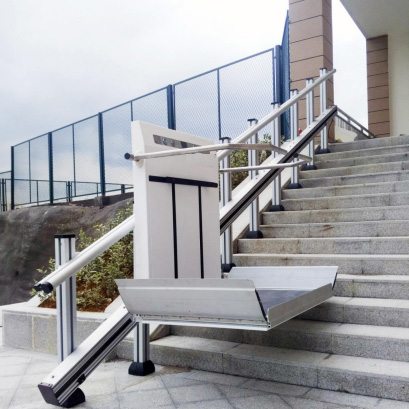
Inclined wheelchair lifts and vertical lifts are two different types of accessibility solutions that provide wheelchair users with a way to access buildings or different levels within a building. While both types of lifts serve the same general purpose, there are several key differences between them.
Inclined wheelchair lifts are typically designed to travel along a staircase at an angle. They are installed on a rail system that is attached to the stairs, allowing the lift to move up and down the stairs while carrying a wheelchair user. Inclined wheelchair lifts are often foldable or retractable when not in use, which helps to save space and keep the staircase clear for other pedestrians.
Vertical lifts, on the other hand, are designed to move vertically between different levels of a building. They are usually enclosed in a shaft or structure, providing wheelchair users with a safe and secure way to access different floors. Vertical lifts can also be open-platform or enclosed, depending on the specific requirements of the building and the preferences of the user.
Inclined wheelchair lifts are suitable for buildings with multiple levels that have existing staircases. They provide wheelchair users with a convenient and efficient way to access different floors without the need to transfer out of their wheelchair. However, inclined wheelchair lifts are limited to traveling along a staircase, so they may not be suitable for buildings with limited space or complex layouts.
Vertical lifts are more versatile in terms of the locations they can be installed. They can be installed indoors or outdoors, and they can be customized to fit the specific requirements of the building. Vertical lifts can also travel to different levels within the building, providing wheelchair users with access to all floors. Vertical lifts are a popular choice for buildings that do not have existing staircases or where space is limited.
Inclined wheelchair lifts require a staircase to be installed on. This means that the staircase must have enough space to accommodate the rail system and the lift itself. Inclined wheelchair lifts are not suitable for buildings with narrow or steep staircases, as they may not be able to operate safely in these conditions.
Vertical lifts require a shaft or structure to be installed in. This means that the building must have enough space to accommodate the lift and its associated components. Vertical lifts are a good choice for buildings with limited space, as they can be installed in a small footprint and do not require additional space for a staircase.
Inclined wheelchair lifts are typically easier and quicker to install compared to vertical lifts. Since inclined wheelchair lifts are installed on an existing staircase, there is no need for major modifications to the building structure. Inclined wheelchair lifts can usually be installed in a matter of days or weeks, depending on the complexity of the installation.
